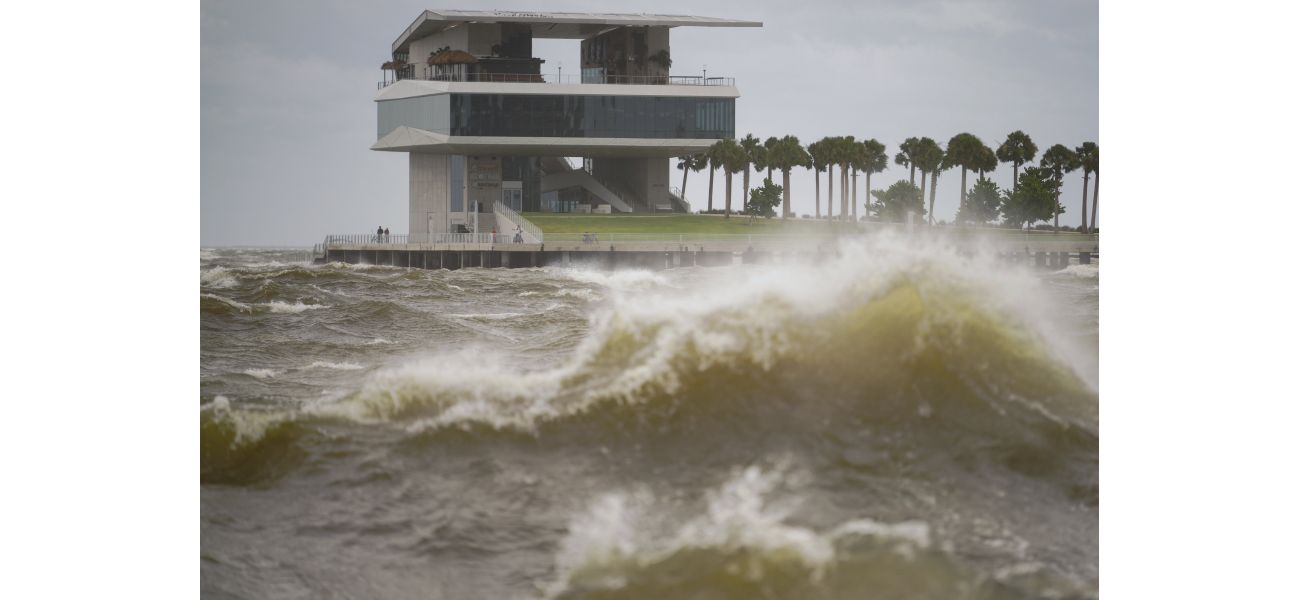Hurricane Helene hits northwestern Florida as a powerful Category 4 storm.
Strong winds have caused power outages for over 250,000 properties, leading to emergency declarations in multiple states.
September 27th 2024.

On Thursday evening, a powerful and fast-moving Hurricane Helene made its way to the Big Bend area of Florida's northwestern coast. It was classified as a Category 4 storm, with forecasters issuing warnings of potential catastrophic damage from storm surges, strong winds, heavy rains, and flash floods. This severe weather was expected to stretch for hundreds of miles inland across the southeastern US.
As Helene approached, authorities in Georgia reported two fatalities from a possible tornado, and Florida Governor Ron DeSantis confirmed one death on Interstate 4 when a sign fell onto a car. The storm also caused power outages for over 1 million homes and businesses in Florida and over 50,000 in Georgia.
States of emergency were declared in Florida, Georgia, the Carolinas, Virginia, and Alabama. Meanwhile, in the Pacific, former Hurricane John regained strength and was upgraded to a hurricane again, posing a threat to parts of Mexico's western coast with potential flash flooding and mudslides. On the other side of the Atlantic, Tropical Storm Isaac formed and was predicted to strengthen into a hurricane as it moved away from the US.
Governor DeSantis expressed concern for the safety of Floridians and urged them to stay indoors and take necessary precautions. He also warned that more fatalities and property damage were likely as the storm continued to progress. The governor announced that 3,500 National Guardsmen were ready to assist with emergency response efforts.
Shortly after, Hurricane Helene made landfall in northwestern Florida near Perry, with maximum sustained winds of 140 mph. The National Hurricane Center in Miami also warned of potentially catastrophic and unsurvivable storm surges of up to 20 feet in Florida's Apalachee Bay. As a result, hurricane and flash flood warnings were issued for areas far beyond the coast, including northern Georgia and western North Carolina.
As the storm raged on, the number of power outages continued to rise, with over 885,000 customers in Florida without electricity. The majority of these outages were concentrated in counties in the Big Bend area, where Helene was expected to make landfall.
Meanwhile, former Hurricane John was downgraded to a tropical storm as it slowly moved along the coast of Mexico's Michoacan state. However, the US National Hurricane Center warned that it could still cause severe flash flooding. John initially hit Mexico as a Category 3 hurricane before weakening and then regaining strength as a tropical storm. The hurricane center predicted that it would continue to weaken as it moved further along the coast.
On Thursday evening, Hurricane Helene, a fast-moving Category 4 storm, made landfall in the Big Bend area of Florida's northwestern coast. The storm brought with it a potential "catastrophic" storm surge, as well as damaging winds, heavy rains, and flash floods that could affect areas hundreds of miles inland across the southeastern United States, according to forecasters.
As Helene approached, two people were reported to have been killed in a possible tornado in south Georgia, and one person died while driving on Interstate 4 in Florida when a sign fell onto their car, as reported by authorities in Georgia and Florida Governor Ron DeSantis, respectively.
The storm also caused widespread power outages, affecting over 1 million homes and businesses in Florida and over 50,000 in Georgia. States of emergency were declared in multiple states, including Florida, Georgia, the Carolinas, Virginia, and Alabama.
Meanwhile, in the Pacific, former Hurricane John regained strength as it moved toward Mexico's western coast, threatening areas with flash flooding and mudslides. However, it was later downgraded to a tropical storm as it crept along the coast of the Mexican state of Michoacan.
Additionally, Tropical Storm Isaac formed in the Atlantic Ocean on Wednesday and is expected to strengthen as it moves eastward away from the United States. It could potentially become a hurricane by the end of the week, according to forecasters.
Governor DeSantis urged residents to take precautions and stay safe, as he confirmed one fatality and warned of the possibility of more as the storm continues to advance. He also mentioned that 3,500 National Guardsmen were on standby to assist with response efforts.
Hurricane Helene officially made landfall near Perry, Florida, in the Big Bend area of the state's Gulf Coast, with maximum sustained winds of 140 mph. The National Hurricane Centre in Miami issued warnings of potentially catastrophic flooding along the Gulf Coast, particularly in Florida's Apalachee Bay.
The effects of the storm extended far beyond the coast, with hurricane and flash flood warnings reaching as far as northern Georgia and western North Carolina.
As of Thursday night, over 885,000 customers in Florida were without power, according to poweroutage.us. The majority of these outages were concentrated in the Big Bend area, where Helene was expected to make landfall.
Meanwhile, former Hurricane John, now a tropical storm, continued to move slowly along the coast of Mexico's Michoacan state. The storm was downgraded Thursday evening, but was still sustaining wind speeds of 70 mph. It posed a threat of severe flash flooding to coastal areas.
John initially hit Mexico on Monday as a Category 3 hurricane, causing significant damage before weakening and reemerging over the ocean. It regained strength as a tropical storm on Wednesday and strengthened back into a hurricane on Thursday. However, the National Hurricane Centre predicts that it will weaken again by Thursday night and into Friday.
The potential for further damage and loss of life remains a concern as these powerful storms continue to move through the region. Governor DeSantis urged people to keep the affected areas and those who have been impacted in their thoughts and prayers.
As Helene approached, authorities in Georgia reported two fatalities from a possible tornado, and Florida Governor Ron DeSantis confirmed one death on Interstate 4 when a sign fell onto a car. The storm also caused power outages for over 1 million homes and businesses in Florida and over 50,000 in Georgia.
States of emergency were declared in Florida, Georgia, the Carolinas, Virginia, and Alabama. Meanwhile, in the Pacific, former Hurricane John regained strength and was upgraded to a hurricane again, posing a threat to parts of Mexico's western coast with potential flash flooding and mudslides. On the other side of the Atlantic, Tropical Storm Isaac formed and was predicted to strengthen into a hurricane as it moved away from the US.
Governor DeSantis expressed concern for the safety of Floridians and urged them to stay indoors and take necessary precautions. He also warned that more fatalities and property damage were likely as the storm continued to progress. The governor announced that 3,500 National Guardsmen were ready to assist with emergency response efforts.
Shortly after, Hurricane Helene made landfall in northwestern Florida near Perry, with maximum sustained winds of 140 mph. The National Hurricane Center in Miami also warned of potentially catastrophic and unsurvivable storm surges of up to 20 feet in Florida's Apalachee Bay. As a result, hurricane and flash flood warnings were issued for areas far beyond the coast, including northern Georgia and western North Carolina.
As the storm raged on, the number of power outages continued to rise, with over 885,000 customers in Florida without electricity. The majority of these outages were concentrated in counties in the Big Bend area, where Helene was expected to make landfall.
Meanwhile, former Hurricane John was downgraded to a tropical storm as it slowly moved along the coast of Mexico's Michoacan state. However, the US National Hurricane Center warned that it could still cause severe flash flooding. John initially hit Mexico as a Category 3 hurricane before weakening and then regaining strength as a tropical storm. The hurricane center predicted that it would continue to weaken as it moved further along the coast.
On Thursday evening, Hurricane Helene, a fast-moving Category 4 storm, made landfall in the Big Bend area of Florida's northwestern coast. The storm brought with it a potential "catastrophic" storm surge, as well as damaging winds, heavy rains, and flash floods that could affect areas hundreds of miles inland across the southeastern United States, according to forecasters.
As Helene approached, two people were reported to have been killed in a possible tornado in south Georgia, and one person died while driving on Interstate 4 in Florida when a sign fell onto their car, as reported by authorities in Georgia and Florida Governor Ron DeSantis, respectively.
The storm also caused widespread power outages, affecting over 1 million homes and businesses in Florida and over 50,000 in Georgia. States of emergency were declared in multiple states, including Florida, Georgia, the Carolinas, Virginia, and Alabama.
Meanwhile, in the Pacific, former Hurricane John regained strength as it moved toward Mexico's western coast, threatening areas with flash flooding and mudslides. However, it was later downgraded to a tropical storm as it crept along the coast of the Mexican state of Michoacan.
Additionally, Tropical Storm Isaac formed in the Atlantic Ocean on Wednesday and is expected to strengthen as it moves eastward away from the United States. It could potentially become a hurricane by the end of the week, according to forecasters.
Governor DeSantis urged residents to take precautions and stay safe, as he confirmed one fatality and warned of the possibility of more as the storm continues to advance. He also mentioned that 3,500 National Guardsmen were on standby to assist with response efforts.
Hurricane Helene officially made landfall near Perry, Florida, in the Big Bend area of the state's Gulf Coast, with maximum sustained winds of 140 mph. The National Hurricane Centre in Miami issued warnings of potentially catastrophic flooding along the Gulf Coast, particularly in Florida's Apalachee Bay.
The effects of the storm extended far beyond the coast, with hurricane and flash flood warnings reaching as far as northern Georgia and western North Carolina.
As of Thursday night, over 885,000 customers in Florida were without power, according to poweroutage.us. The majority of these outages were concentrated in the Big Bend area, where Helene was expected to make landfall.
Meanwhile, former Hurricane John, now a tropical storm, continued to move slowly along the coast of Mexico's Michoacan state. The storm was downgraded Thursday evening, but was still sustaining wind speeds of 70 mph. It posed a threat of severe flash flooding to coastal areas.
John initially hit Mexico on Monday as a Category 3 hurricane, causing significant damage before weakening and reemerging over the ocean. It regained strength as a tropical storm on Wednesday and strengthened back into a hurricane on Thursday. However, the National Hurricane Centre predicts that it will weaken again by Thursday night and into Friday.
The potential for further damage and loss of life remains a concern as these powerful storms continue to move through the region. Governor DeSantis urged people to keep the affected areas and those who have been impacted in their thoughts and prayers.
[This article has been trending online recently and has been generated with AI. Your feed is customized.]
[Generative AI is experimental.]
0
0
Submit Comment





